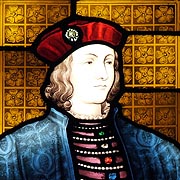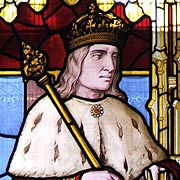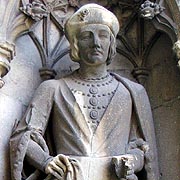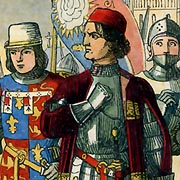
Edward IV (1442-1483) - King of
England 1461-1470 & 1471-1483
 |
 |

|

|
King Edward IV was the eldest son of Richard, Duke of York (son of Prince Richard of Conisburgh, Earl of Cambridge) and Cecily Neville. He was born at Rouen and shared, from 1455, in his father's vicissitudes at the commencement of the War of the Roses. We find him in the neighbourhood of St. Albans, at Ludlow, an exile in Ireland, Guernsey and Calais. His first title was Earl of March and it was by that title that he was attainted by a Lancastrian Parliament in 1459. From Calais, in 1460, he came to England, and helped the Yorkists to win the Battle of Northampton. When his father was defeated and slain at Wakefield, he resolved on claiming the Crown for himself. He defeated the Western Lancastrians at Mortimer's Cross in February 1461, pushed on to London, where he was received as King, and then, without waiting to be crowned, hurried northwards and annihilated Queen Margaret's great Northern army at the Battle of Towton. This left him in secure possession of all England but a few Northern castles which were gradually taken.
Fresh risings of Lancastrians were easily defeated in 1464, and in the next year the captive Henry VI was sent to the Tower. But Edward, though owing his victories in the field wholly to his own excellent grasp of strategy and tactics, had really owed his throne to the support of the powerful family of Neville, with which he soon managed to quarrel. Richard ‘the Kingmaker’ Neville, Earl of Warwick, the head of this family, expected Edward to be guided by his counsels in the matter of his marriage as in everything else. Edward, however, fell in love with the lowly Elizabeth Woodville, widow of Sir John Grey, and secretly married her. When the marriage was declared to the World at Reading Abbey, Warwick chose to be offended, and he was still more offended by Edward’s zeal for a Burgundian as opposed to a French alliance. He thereupon determined, in 1469, to upset his puppet King, and the first tool of which he made use was Edward’s vain and foolish brother, the Duke of Clarence. Edward, who, in spite of his military talents, was slow to take the field in person, was captured and imprisoned. Yet Warwick hesitated to put Clarence on the throne and was, therefore, obliged to release his captive. A fresh treason of Warwick opened the King's somewhat sleepy eyes and he defeated Warwick and Clarence at Stamford in 1470. They thereon fled to France, and Warwick at last threw himself into the arms of the Lancastrians.
On the news of this, other partisans of the Nevilles in England rose in arms and forced Edward to flee to the Low Countries. Warwick returned to England and put Henry VI again upon the throne. But the Duke of Burgundy who, much as he hated Edward, hated France more, looked upon the Lancastrian Restoration wholly as a French job, and supplied Edward with money for a fresh attempt upon England. Edward landed in Yorkshire and professed, at first, only to claim his own Duchy of York. However, being gradually better and better received as he marched southwards, soon resolved to claim the Crown again. Warwick was no match for Edward as a general, was defeated and slain at Barnet in April 1471 and, three weeks later, Queen Margaret and the true Lancastrians were equally annihilated at Tewkesbury. Bloody reprisals followed these victories, as indeed they followed the victories of each side in these horrible wars. Among Edward's victims were King Henry VI and his only son, Prince Edward of Lancaster.
The rest of Edward's reign was tranquil. He invaded France with a very large army in 1474, but he early let the King of France understand that he was not very much in earnest, that it was the sort of thing a spirited King of England was expected to do, but that a round sum of money, which the English could call a tribute and the French a pension, would buy his retreat. The wily Louis XI agreed to these terms and even promised to wed his son, the Dauphin, to Edward's eldest daughter. Edward put his brother, Clarence, to death in 1478. The motive seems to have been jealousy, whether ill or well founded it is difficult to say. He even managed to quarrel to some extent with his surviving brother, Richard of Gloucester, who had been perfectly loyal to him, before the end of his reign. He died in his forty-first year in 1483 and was briefly succeeded by his young son, Edward V.
All that we know of Edward's character is entirely to his discredit. His only ability was that of the soldier and his laziness, at the times when he should have been most active, decidedly counterbalanced his military talents. He was sensual and immoral to a flagrant extent, and drink and debauchery probably hastened his end. He was also vindictive, suspicious and cruel to a degree remarkable even in that age of blood. He professed some interest in letters and allowed Caxton to set up a press at Westminster. In person, he was, for that age, a giant, being six feet three inches tall, and was considered, although his portraits belie it, to have been of great personal beauty. It is easy for kings to be thought handsome.
Edited from CRL Fletcher's 'Historical Portraits' (1909)
The pictures on this page are cropped examples of images in our high resolution photo library. Please e-mail us for details of these or similar image availability at our very reasonable reproduction rates. Location release may be required for some photos.
Click for Next
Monarch